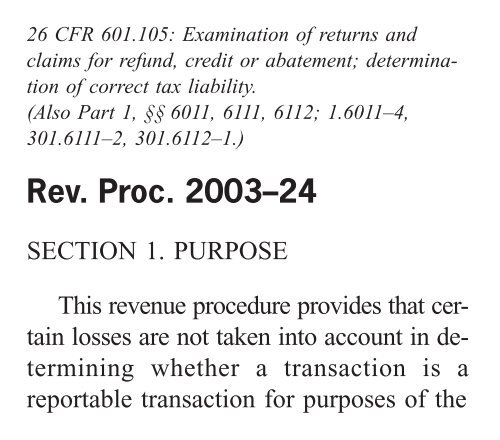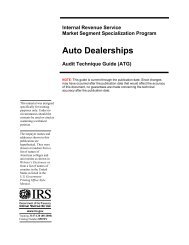Rev. Proc. 2003-24
Rev. Proc. 2003-24
Rev. Proc. 2003-24
You also want an ePaper? Increase the reach of your titles
YUMPU automatically turns print PDFs into web optimized ePapers that Google loves.
26 CFR 601.105: Examination of returns and<br />
claims for refund, credit or abatement; determination<br />
of correct tax liability.<br />
(Also Part 1, §§ 6011, 6111, 6112; 1.6011–4,<br />
301.6111–2, 301.6112–1.)<br />
<strong>Rev</strong>. <strong>Proc</strong>. <strong>2003</strong>–<strong>24</strong><br />
SECTION 1. PURPOSE<br />
This revenue procedure provides that certain<br />
losses are not taken into account in determining<br />
whether a transaction is a<br />
reportable transaction for purposes of the
disclosure rules under § 1.6011–4(b)(5) of<br />
the Income Tax Regulations.<br />
SECTION 2. BACKGROUND<br />
.01 Section 1.6011–4 requires a taxpayer<br />
who participates in a reportable transaction<br />
to disclose the transaction in<br />
accordance with the procedures provided in<br />
§ 1.6011–4. Under § 1.6011–4(b), there are<br />
six categories of reportable transactions. One<br />
category of reportable transaction is a loss<br />
transaction. A loss transaction is defined in<br />
§ 1.6011–4(b)(5).<br />
.02 Section 1.6011–4(b)(8)(i) provides<br />
that a transaction will not be considered a<br />
reportable transaction, or will be excluded<br />
from any individual category of reportable<br />
transaction, if the Commissioner makes<br />
a determination by published guidance that<br />
the transaction is not subject to the reporting<br />
requirements of § 1.6011–4.<br />
SECTION 3. SCOPE<br />
This revenue procedure applies to taxpayers<br />
that may be required to disclose reportable<br />
transactions under § 1.6011–4<br />
and/or material advisors that may be required<br />
to maintain lists under § 301.6112–1.<br />
SECTION 4. APPLICATION<br />
.01 In general. Losses from the sale or<br />
exchange of an asset with a qualifying basis<br />
under section 4.02 or losses described<br />
in section 4.03 of this revenue procedure<br />
are not taken into account in determining<br />
whether a transaction is a reportable transaction.<br />
.02 Sale or exchange of an asset with a<br />
qualifying basis.<br />
(1) General rule. A loss under § 165 of<br />
the Internal <strong>Rev</strong>enue Code from the sale or<br />
exchange of an asset is not taken into account<br />
in determining whether a transaction<br />
is a loss transaction under § 1.6011–<br />
4(b)(5) if—<br />
(a) the basis of the asset (for purposes<br />
of determining the loss) is a qualifying basis;<br />
(b) the asset is not an interest in a<br />
passthrough entity (within the meaning of<br />
§ 1260(c)(2));<br />
(c) the loss from the sale or exchange<br />
of the asset is not treated as ordinary under<br />
§ 988;<br />
(d) the asset has not been separated from<br />
any portion of the income it generates; and<br />
(e) the asset is not, and has never been,<br />
part of a straddle within the meaning of<br />
§ 1092(c), excluding a mixed straddle under<br />
§ 1.1092(b)–4T.<br />
(2) Qualifying basis. For purposes of<br />
section 4 of this revenue procedure, a taxpayer’s<br />
basis in an asset (less adjustments<br />
for any allowable depreciation, amortization,<br />
or casualty loss) is a qualifying basis<br />
if—<br />
(a) the basis of the asset is equal to, and<br />
is determined solely by reference to, the<br />
amount (including any option premium)<br />
paid in cash by the taxpayer for the asset<br />
and for any improvements to the asset;<br />
(b) the basis of the asset is determined<br />
under § 358 by reason of a transaction under<br />
§ 355 or § 368, and the taxpayer’s basis<br />
in the property exchanged in the<br />
transaction was described in this section<br />
4.02(2);<br />
(c) the basis of the asset is determined<br />
under § 1014;<br />
(d) the basis of the asset is determined<br />
under § 1015, and the donor’s basis in the<br />
asset was described in this section 4.02(2);<br />
or<br />
(e) the basis of the asset is determined<br />
under § 1031(d), the taxpayer’s basis in the<br />
property that was exchanged for the asset<br />
in the § 1031 transaction was described in<br />
this section 4.02(2), and any debt instrument<br />
issued or assumed by the taxpayer in<br />
connection with the § 1031 transaction is<br />
treated as a payment in cash under section<br />
4.02(3) of this revenue procedure.<br />
(3) Debt instruments. Except as provided<br />
below, an amount paid in cash will<br />
not be disregarded for purposes of section<br />
4.02(2) of this revenue procedure<br />
merely because the taxpayer issued a debt<br />
instrument to obtain the cash. However, if<br />
the taxpayer has issued a debt instrument<br />
to the person (or a related party as described<br />
in § 267(b) or § 707(b)) who sold<br />
or transferred the asset to the taxpayer, assumed<br />
a debt instrument (or took an asset<br />
subject to a debt instrument) issued by<br />
the person (or a related party as described<br />
in § 267(b) or § 707(b)) who sold or transferred<br />
the asset to the taxpayer, or issued<br />
a debt instrument in exchange for improvements<br />
to an asset, the taxpayer will be<br />
treated as having paid cash for the asset or<br />
the improvement only if the debt instrument<br />
is secured by the asset and all amounts<br />
due under the debt instrument have been<br />
paid in cash no later than the time of the<br />
sale or exchange of the asset (except in the<br />
case of stock or securities traded on an established<br />
securities market, the settlement<br />
date) for which the loss is claimed.<br />
.03 Other losses. The following losses<br />
under § 165 are not taken into account in<br />
determining whether a transaction is a loss<br />
transaction under § 1.6011–4(b)(5):<br />
(1) A loss from fire, storm, shipwreck,<br />
or other casualty, or from theft, under<br />
§ 165(c)(3);<br />
(2) A loss from a compulsory or involuntary<br />
conversion as described in<br />
§§ 1231(a)(3)(A)(ii) and 1231(a)(4)(B);<br />
(3) A loss arising from any markto-market<br />
treatment of an item under<br />
§§ 475, 1256, 1296(a), 1.446–4(e), 1.988–<br />
5(a)(6), or 1.1275–6(d)(2), provided that the<br />
taxpayer computes its loss by using a qualifying<br />
basis (as defined in section 4.02(2)<br />
of this revenue procedure) or a basis resulting<br />
from previously marking the item<br />
to market, or computes its loss by making<br />
appropriate adjustments for previously<br />
determined mark-to-market gain or loss as<br />
provided, for example, in § 475(a) or<br />
§ 1256(a)(2);<br />
(4) A loss arising from a hedging<br />
transaction described in § 1221(b), if the<br />
taxpayer properly identifies the transaction<br />
as a hedging transaction, or from a<br />
mixed straddle account under § 1.1092(b)–<br />
4T;<br />
(5) A loss attributable to basis increases<br />
under § 860C(d)(1) during the period<br />
of the taxpayer’s ownership;<br />
(6) A loss attributable to the abandonment<br />
of depreciable tangible property<br />
that was used by the taxpayer in a trade or<br />
business and that has a qualifying basis under<br />
section 4.02(2) of this revenue procedure;<br />
(7) A loss arising from the bulk sale<br />
of inventory if the basis of the inventory is<br />
determined under § 263A; or<br />
(8) A loss that is equal to, and is determined<br />
solely by reference to, a payment<br />
of cash by the taxpayer (for example,<br />
a cash payment by a guarantor that results<br />
in a loss or a cash payment that is<br />
treated as a loss from the sale of a capital<br />
asset under § 1234A or § 1234B).<br />
SECTION 5. EFFECTIVE DATE<br />
This revenue procedure is effective for<br />
transactions entered into on or after February<br />
28, <strong>2003</strong>. However, if a taxpayer applies<br />
§ 1.6011–4 retroactively, as provided
in § 1.6011–4(h), to transactions entered into<br />
on or after January 1, <strong>2003</strong>, then this revenue<br />
procedure will be effective January 1,<br />
<strong>2003</strong>, for those transactions.<br />
SECTION 6. DRAFTING<br />
INFORMATION<br />
The principal author of this revenue procedure<br />
is Tara P. Volungis of the Office of<br />
Associate Chief Counsel (Passthroughs and<br />
Special Industries). For further information<br />
regarding this revenue procedure, contact<br />
Ms. Volungis at (202) 622–3080 (not<br />
a toll-free call).
















